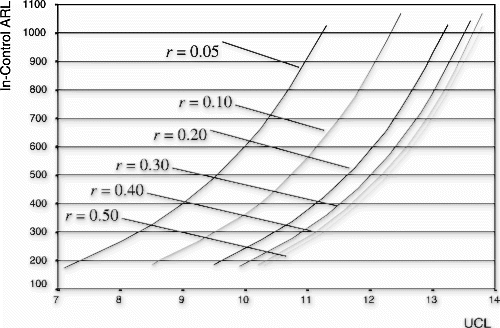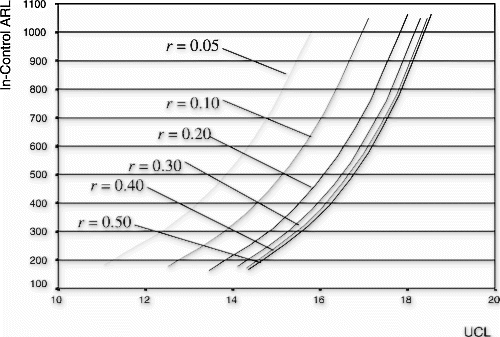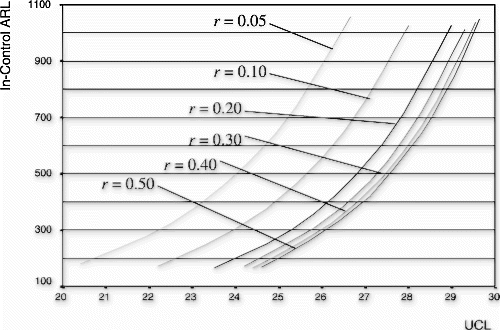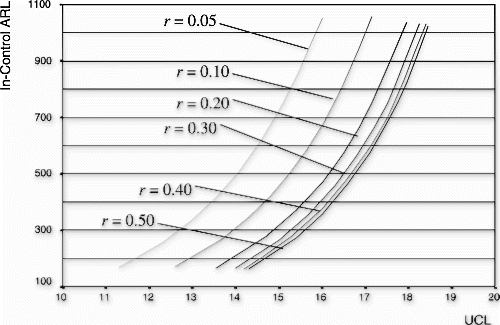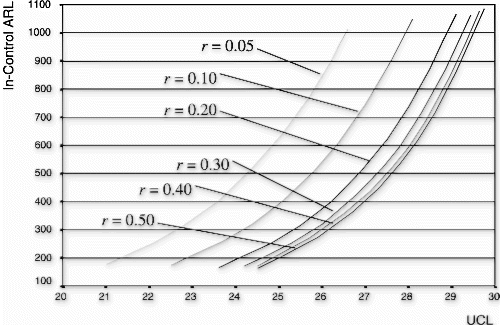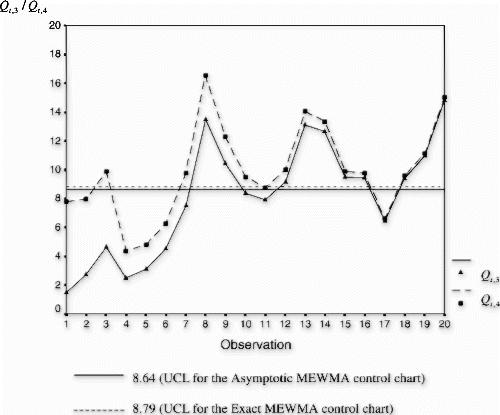Abstract
A multivariate exponentially weighted moving average (MEWMA) control chart is used for fast detection of small shifts in multivariate statistical quality control. However, for ease of computation, the MEWMA control chart statistics are computed based on the asymptotic form of their covariance matrix in most cases. Another reason that justifies the design of the MEWMA control chart using the asymptotic covariance matrix is that the chart will be insensitive at start-up since processes are more likely to be away from the target value when the control scheme is initiated due to start-up problems. However, if initial out-of-control conditions are deemed important for quick detection, then the MEWMA statistics should be computed based on the exact covariance matrix, as it leads to a natural fast initial response for the MEWMA chart. It will also be shown in this paper the importance of computing the MEWMA statistics based on the exact form of their covariance matrix to further enhance the MEWMA control chart's sensitivity for detecting small shifts. The MEWMA statistics based on the asymptotic and the exact form of their covariance matrix will be referred to as the asymptotic and the exact MEWMA statistics, respectively. Plots and factors that simplify the design of the exact MEWMA control chart are also given.
Introduction
A multivariate exponentially weighted moving average (MEWMA) control chart is to superior the Hotelling's χ 2 control chart for detecting small shifts in a multivariate process distribution, as the latter uses information only from the current sample, making it relatively insensitive to small shifts in the mean vector (Citation1). To date, much research on MEWMA charts has been done (Citation1 Citation2 Citation3 Citation4). The MEWMA control chart is based on the following statistics (Citation3):
The MEWMA control chart based on the exact form of the covariance matrix:
Plots Of Arl0 Versus Ucl
Plots of ARL0 (where ARL0 denotes the in-control ARL) vs. UCL for the asymptotic MEWMA control chart based on the number of quality characteristics, p=2,4, and 10 and values of r=0.05, 0.10, 0.20, 0.30, 0.40, and 0.50, are given in Figs. , , , respectively. The corresponding plots for the Exact MEWMA control chart are given in Figs. , , . These plots can be used to approximate the UCL values for values of ARL0 ranging from 200 to 1000. Note that each of the above plots is obtained based on a simulation study of 10,000 runs carried out using the SAS programming language, version 6.12.
The following two steps are taken in determining the UCL value for a particular MEWMA control chart scheme. First, approximate the UCL value from the plots in Figs. , , , , , based on the values of p, r, and ARL0 of our choice. Next, a sensitivity analysis is performed to obtain an exact value of UCL based on the value of ARL0. The sensitivity analysis is done using SAS, version 6.12. Computer programs written in the SAS language that corresponds to Figs. , , , , , are given as programs 1–6 in the Appendix. Note that computer programs can also be written in other programming languages such as Fortran, C++, etc.
For example, suppose that the ARL0 value for the asymptotic MEWMA for p=2 and r=0.05 is set equal to 200. Then, from Fig. , its approximated UCL value is somewhere between 7.3 and 7.4. A sensitivity analysis is performed using program 1 of the SAS language for values of UCL ranging from 7.3 to 7.4. This is illustrated in Table . Based on Table , the value of UCL=7.37 is found to give the closest value (i.e., 200.2) to the desired ARL0 value 200.
Table 1. A sensitivity analysis for determining the exact UCL for the asymptotic MEWMA chart based on p=2, r=0.05, and ARL0=200
Factors For Computing The Exact Mewma Statistics
From Eqs. Equation2 Equation3 Equation4, it can be easily shown that the Exact MEWMA is related to the asymptotic MEWMA only through a factor:
Table 2. Factors for the exact MEWMA statistics (f r,t =[1−(1−r)2t ]−1)
Comparing the Performances of the asymptotic MEWMA and the Exact MEWMA Control Charts
Simulation studies are carried out using SAS, version 6.12, to compare the ARL performances of the two types of MEWMA control charts. The results for the asymptotic MEWMA control chart are given in Table , while those of the Exact MEWMA control chart are given in Table . Note that the number of quality characteristics considered in both cases are p=2, 4, and 10 for values of r=0.05, 0.10, 0.20, 0.30, 0.40, and 0.50. Here, the in-control mean vector is μ0=(0,0, … ,0)′ and the out-of-control mean vector is μ s =(δ,0, … ,0)′, which results in a shifted distance given by the square root of the noncentrality parameter, λ=δ, where:
Table 3. ARL profile for the asymptotic MEWMA control chart schemes
Table 4. ARL profile for the exact MEWMA control chart schemes
Using the same values of UCLs for the Exact MEWMA control chart as shown in Table results in a slight drop in all the ARL0 values, although the sensitivities of the Exact MEWMA control chart schemes in detecting shifts in the mean vector are better than those of the asymptotic MEWMA control chart. Therefore, the UCLs for all Exact MEWMA control chart schemes must be increased so that similar ARL0 values are obtained for all schemes. The new UCLs which are larger than that of the asymptotic MEWMA, can be easily approximated using Figs. , , . A sensitivity analysis is then performed using programs 4–6 given in the Appendix to obtain the exact UCLs for all Exact MEWMA schemes. The ARL profiles for the Exact MEWMA control chart schemes based on these new and larger UCLs are also given in Table (see boldfaced values).
The boldfaced ARL profiles in Table show that the performance of the Exact MEWMA control chart is superior to that of the asymptotic MEWMA control chart (see Table ), especially for smaller values of r. For example, for p=2, r=0.05, and λ=0.5, the ARL value in Table is 26.8, while the corresponding boldfaced ARL value in Table is 21.1, which is an improvement of about 21% using the Exact MEWMA control chart. However, as the value of r increases, the performances of the Exact MEWMA and the asymptotic MEWMA control charts are about the same.
Example
In this section, an example will be given showing how the Exact MEWMA control chart is put to work using the proposed procedure based on Figs. , , and the factor, f r,t =[1−(1−r)2t ]−1 where t=1,2, … , shown in Table .
This example is based on observations generated from a bivariate normal distribution using SAS, version 6.12. An initial out-of-control is assumed; i.e., the process starts with an off-target situation. Twenty observations are generated from a bivariate normal N
2(μ
s
,Σ0) distribution where μ
s
=(δ,0)′, ρ=0, δ=1.0, and the in-control mean vector is μ0=(0,0)′. Here, the magnitude of the shift given by the square root of the noncentrality parameter is λ=1.0.
Assume that the smoothing parameter r is set equal to 0.1 for both the Exact and the asymptotic MEWMA control charts. If the type-I error is set at 0.005, then ARL0={ 1 0.005 }=200 and using the proposed procedure gives the UCLs for the Exact and the asymptotic MEWMA as 8.79 and 8.64, respectively. The bivariate measurements generated, denoted as X 1 and X 2, and the corresponding computed Q t,3 statistics for the asymptotic MEWMA using Eqs. Equation2 Equation3 are given in Table . Note that the Q t,4 statistics are then computed using Eq. Equation(6).
Table 5. Q t,3 and Q t,4 statistics for r=0.1
The plotted Q t,3 and Q t,4 statistics are shown in Fig. together with their respective UCLs. Note that the Exact MEWMA control chart based on Q t,4 statistics signals an out-of-control at observation 3, whereas the asymptotic MEWMA control chart based on Q t,3 statistics gives an out-of-control signal only at observation 8; i.e., five observations slower than the Exact MEWMA. This simple example illustrates the superiority of the Exact MEWMA control chart to the asymptotic MEWMA control chart, where the former performs better than the latter.
Conclusion
This paper highlights the importance of computing the MEWMA statistics based on their exact, time-dependent covariance matrix given in Eq. Equation(4), which increases the MEWMA control chart's sensitivity for detecting small shifts. In addition, the proposed procedure based on Figs. , , , a sensitivity analysis, and the factors in Table provide an easy way of constructing an Exact MEWMA control chart based on an existing asymptotic MEWMA control chart. Quality control practitioners who are traditional users of an asymptotic MEWMA control chart can now opt for a better and more robust MEWMA control chart, i.e., the Exact MEWMA, without much difficulty.
Acknowledgments
I express thanks to the referee, Professor Erhan Mergen, for his helpful suggestions and comments, which helped improve the contents and style of this paper.
References
- Lowry , C. A. , Woodall , W. H. , Champ , C. W. and Rigdon , S. E. 1992 . A multivariate exponentially weighted moving average control chart . Technometrics , 34 ( 1 ) : 46 – 53 .
- Montgomery , D. C. 2001 . Introduction to Statistical Quality Control , 4th ed. New York : Wiley and Sons .
- Prabhu , S. S. and Runger , G. C. 1997 . Designing a multivariate EWMA control chart . J. Qual. Technol. , 29 ( 1 ) : 8 – 15 .
- Runger , G. C. and Prabhu , S. S. 1996 . A Markov chain model for the multivariate exponentially weighted moving averages control chart . J. Am. Statist. Assoc. , 91 ( 436 ) : 1701 – 1706 .
Appendix
Computer programs written in the SAS, version 6.12, language that correspond to Figs. , , , , , will be given in this section as programs 1–6, respectively. The boldfaced UCL value in each program is first set equal to the approximated UCL based on Figs. , , , , , , and then adjusted accordingly to obtain the exact ARL0. A soft copy of these programs can be obtained from the author.
